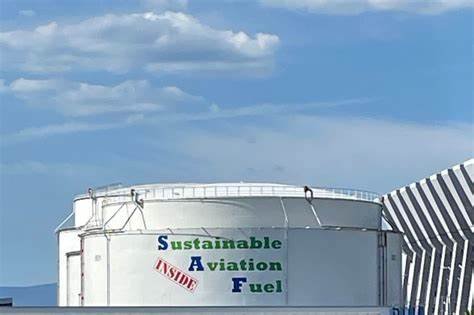The process of producing SUSTAINABLE AVIATION FUEL “SAF” from biodiesel involves a series of steps. following a general overview of the process:
1. Biodiesel production: Biodiesel is typically produced through the transesterification of vegetable oils or animal fats. This process involves reacting the oils or fats with an alcohol (such as methanol) and a catalyst to produce biodiesel and glycerol as a byproduct.
2. Hydrodeoxygenation (HDO): The next step is to convert biodiesel into a hydrocarbon feedstock suitable for SAF production. HDO is a common method used for this purpose. In this process, the biodiesel is reacted with hydrogen under specific temperature and pressure conditions, typically using a catalyst, to remove oxygen and reduce the oxygen content in the fuel.
3. Isomerization and hydrogenation: The hydrocarbon feedstock obtained from HDO is then subjected to isomerization and hydrogenation processes. Isomerization involves rearranging the molecular structure of the feedstock to improve its cold-flow properties and stability. Hydrogenation is a process where the feedstock is further reacted with hydrogen to enhance its energy density.
4. Distillation and purification: The resulting hydrocarbon mixture is then distilled to separate different fractions based on their boiling points. The desired fraction, suitable for use as SAF, is isolated and purified to remove any impurities or remaining oxygen content.
5. Blending with conventional jet fuel: The final step involves blending the purified SAF with conventional jet fuel, typically in certain proportions specified by aviation fuel standards (currently 50:50) This blending process ensures that the resulting SAF meets the required specifications for use in aircraft engines.
Steam Methane Reformers (“SMR”)
SMR that utilize natural gas are proven commercially. It’s an effective pathway to source the hydrogen required for manufacturing SAF.
Other sources for sourcing hydrogen, although more sustainable, are difficult to produce at a reasonable cost given the high sustainable energy required.
HYFROGEN SOURCES
The hydrogen required for SAF production from biodiesel can come from various sources. Here are a few common methods for sourcing hydrogen:
1. Steam Methane Reforming (SMR): The most widely used method for hydrogen production is steam methane reforming. In this process, natural gas (methane) reacts with steam at high temperatures to produce hydrogen and carbon monoxide. The carbon monoxide is then further reacted to produce additional hydrogen. SMR is a well-established and cost-effective method for large-scale hydrogen production.
2. Electrolysis: Electrolysis is a process that uses electricity to split water molecules into hydrogen and oxygen. If the electricity used for electrolysis comes from renewable sources like solar or wind power, the hydrogen produced is considered renewable as well. This method is known as "green hydrogen." Electrolysis can also utilize electricity from the grid, which may come from a mix of renewable and non-renewable sources, making the resulting hydrogen less sustainable.
3. Biomass Gasification: Biomass gasification is a thermochemical process that converts biomass, such as agricultural waste or wood, into a mixture of gases, including hydrogen. This process involves heating the biomass at high temperatures with a controlled amount of oxygen or steam. The resulting syngas (synthesis gas) can be further processed to extract hydrogen.
4. Other Renewable Sources: Hydrogen can also be produced from other renewable sources, such as solar or wind power, through innovative technologies like solar water splitting or wind electrolysis. These methods directly use renewable energy to generate hydrogen without intermediate steps.
ISOMERIZATION
This step is probably the most important to control in order to have an efficient production and conversion yields when making SAF.
Isomerization plays a crucial role in the production of SAF from biodiesel.
Isomerization involves rearranging the molecular structure of the hydrocarbon feedstock derived from biodiesel to improve its cold-flow properties and stability. This process helps ensure that the SAF meets the necessary specifications for use in aircraft engines. Here's a closer look at the isomerization process:
1. Purpose of isomerization: The hydrocarbon feedstock obtained from the hydrodeoxygenation (HDO) step of biodiesel conversion may contain straight-chain hydrocarbons that have poor low-temperature properties, such as high pour point and cloud point. These properties refer to the temperature at which the fuel begins to solidify or form waxy deposits, which can cause issues in cold weather or at high altitudes. Isomerization is employed to transform these straight-chain hydrocarbons into branched-chain isomers, which have improved cold-flow properties.
2. Catalysts: Isomerization reactions typically require the use of catalysts to facilitate the rearrangement of molecular structures. These catalysts are often based on metals, such as platinum, palladium, or zeolites, which can selectively promote the desired isomerization reactions.
3. Reaction conditions: The isomerization process is carried out under specific temperature and pressure conditions to maximize the yield of desired isomers. The exact conditions can vary depending on the specific feedstock and catalyst used. Elevated temperatures and pressures are typically employed to achieve better conversion rates and isomer selectivity.
4. Reaction mechanism: Isomerization reactions involve breaking and reforming carbon-carbon bonds within the hydrocarbon molecules. The catalyst facilitates these bond rearrangements, leading to the formation of different isomers. The specific mechanisms can vary depending on the feedstock and catalyst used, but generally involve the migration of carbon atoms within the molecule to form branched isomers.
5. Product separation: After the isomerization reaction, the mixture is typically subjected to further separation processes, such as distillation, to isolate the desired isomers with improved cold-flow properties. This helps remove any unconverted feedstock or byproducts from the final SAF product.
By undergoing isomerization, the hydrocarbon feedstock derived from biodiesel is transformed into a mixture of branched-chain isomers that exhibit better low-temperature properties and increased resistance to solidification. This enhances the overall performance and suitability of the SAF for use in aviation applications.
For additional information, please contact the company.

